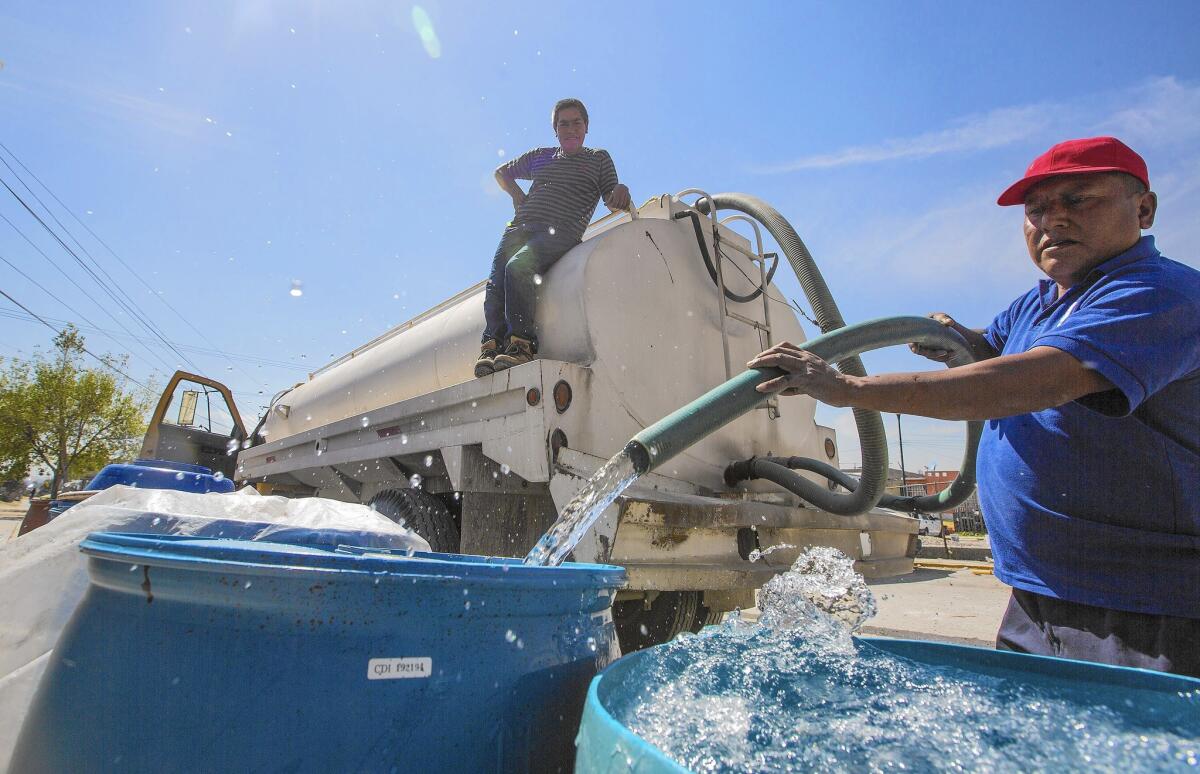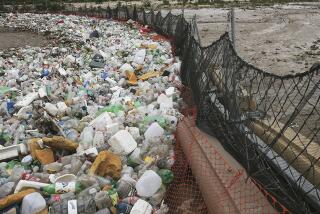Leaking pipes mean Mexico City, flush with water, has to truck it in

The cinder block homes lining the hillsides on the edge of this metropolis are connected to the municipal network of water pipes.
But the water doesn’t arrive that way. It comes on tanker trucks.
Black exhaust and the groans of diesel engines fill the air as an aging fleet makes its deliveries.
Marisol Reyes Jimenez waited patiently as a truck pulled up. The driver unrolled a hose and filled her cistern with enough water to cook meals, wash dishes, do laundry and take showers, at least for the next few days.
Water is one of those things you don’t miss until it’s not there, and here in Iztapalapa, one of the poorest sections of Mexico City, it’s often not. “You have to care for it,” said Jimenez, a 46-year-old homemaker.
In a city built on a lake bed where it rains all summer, the problem isn’t exactly a shortage of water. Rather the infrastructure of pipes is so riddled with cracks that a third of the water the city puts into the system leaks into the ground. It’s gone before it ever has a chance to get here.
“Without the leaks, we would have enough,” said Ramon Aguirre, the director of Mexico City’s water system.
Making matters worse, the city’s population is growing fastest in the places where the water supply is the most unreliable. Home to about 2 million people, Iztapalapa is a common destination for people relocating in search of work.
Wealthier areas of the city, in contrast, usually have enough water to fill their swimming pools, wash their SUVs and water their golf courses.
The disparity is not as simple as the poor being neglected. Instead, its roots go back centuries. When the Aztecs were deciding where to begin constructing their empire in 1325, they chose the islands of Lake Texcoco.
During the colonial period, a debate ensued over what to do with the water surrounding the city. It was often stagnant, triggering fears that it could be a breeding ground for disease. At the same time, dry land was needed for farming, grazing and home building.
The Spaniards decided to drain the lake.
As the water level fell and the population grew, Mexico City radiated outward onto the lake bed.
The most desirable places to live had the cleanest and most accessible drinking water and were the least prone to flooding. At the end of the 19th century, the population was concentrated in areas that today include the posh neighborhoods of west Mexico City.
Starting in the 1920s, crowding drove tenement dwellers farther and farther from the center as they sought land and homes of their own, said Matthew Vitz, a historian at UC San Diego who has studied the city’s complicated relationship with water.
Efforts to extend the water infrastructure failed to keep pace with the city’s expansion.
In 2012, Mexico modified its constitution to guarantee every citizen the right to “safe, acceptable and affordable water.”
“But whether that transfers into the political will to get it done is another question,” Vitz said.
Today, nearly half of Mexico City’s water comes from aquifers, which are often contaminated and whose depletion is causing the city to sink. An additional 40% comes from a reservoir and river to the west. Springs to the south provide the rest.
In the more affluent neighborhoods, most residents pump their water up to their roofs into large cisterns that flow into their homes and apartments.
The tanks offer insurance against interruptions in the city water supply. In January, when the city cut off water to millions of residents for five days to make repairs on the reservoir system, those with cisterns barely noticed. In poorer areas, many residents can’t afford them.
About a million residents — more than a tenth of the city’s population — rely on the trucks for their water. The process is horribly inefficient. The trucks guzzle diesel and some are so old they can hold only enough water to supply two houses on each trip, stretching the delivery schedule well into the night.
“One day you bathe, the next day you don’t. One day you can wash the dishes, the next day you can’t,” said one resident, Linda Hernandez, explaining her struggle for water.
Hernandez works as a volunteer coordinating water deliveries in her Iztapalapa neighborhood. Schools and medical facilities take priority over homes, where residents line their courtyards with buckets, pots and barrels that can be filled when the trucks arrive.
The water is usually not potable — residents throughout the city buy bottled water for drinking — but without it, even basic sanitation is impossible. Hernandez said she became a water activist for her neighborhood because there was not enough water to regularly clean the bathrooms at her daughter’s elementary school.
Her daughter and other children were picking up infections, she said.
There is no simple solution to the city’s water crisis.
In many neighborhoods with severe shortages, residents recycle much the water that gets trucked in. Bathwater is used to flush toilets or wash the patio. Neighbors share any surplus, knowing that soon they may be the ones in need.
Another option is rainwater, which is abundant about half the year but at the moment is mostly funneled into the city’s sewer system, which sends the city’s waste to agricultural areas in the neighboring state of Hidalgo.
A company called Isla Urbana plans to build 10,000 catchment systems over the next three years for $500 to $800 per household. Each will be capable of collecting more than 10,500 gallons a year — enough to dramatically improve quality of life even if it doesn’t eliminate the need for trucks.
Aguirre, the chief of the city’s water system, called rainwater collection a “provisional measure” at best.
As a longer-term solution, he said, the city plans to start construction this year of 22 water recycling plants, which will clean sewage and send the water back to homes, an increasingly common practice in cities around the world. The project is part of a plan to provide water to all residents by 2018.
The city also aims to repair all of its cracked pipes over the next seven years.
But as leaks are patched, new ones are likely to spring open. And if the population keeps growing, it will require even more water to sustain itself.
Tillman is a special correspondent. Special correspondent Cecilia Sanchez contributed to this report.
ALSO
Plaschke: This is a big rookie mistake for D’Angelo Russell
Pregnant woman’s death spurs a safety debate about China’s street fences
Apple wants the FBI to reveal how it hacked the San Bernardino killer’s iPhone
More to Read
Start your day right
Sign up for Essential California for news, features and recommendations from the L.A. Times and beyond in your inbox six days a week.
You may occasionally receive promotional content from the Los Angeles Times.






